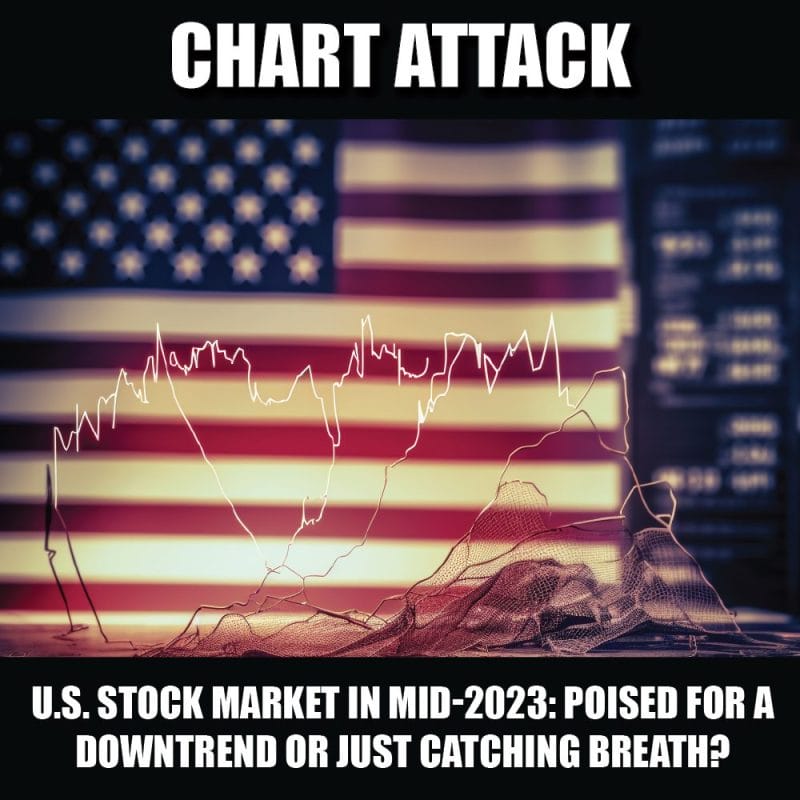As the second quarter of 2023 draws to a close, the U.S. stock market continues to demonstrate remarkable resilience despite looming economic and political uncertainties. Recently, the Nasdaq Composite celebrated its eighth straight winning week while the S&P 500 maintained its bullish trajectory, registering a 2.5% gain in the wake of crucial inflation news and a pause in the Federal Reserve’s rate-hiking campaign.
Technical Analysis
In his recent ‘Chart Attack’ video, Equity Guru’s own Vishal Toora highlighted the resilience of the U.S. stock market as it approached significant technical resistance levels. These key levels could signify a potential trend reversal or continuation, making them of paramount importance to investors.
Vishal observed the market’s response to a ‘red day,’ indicating a slight pullback, and examined the possibilities of a new downtrend or continued upward movement. The market’s reaction at these significant resistance levels is key to understanding its future direction.
Fundamental Influences
Shifting to the fundamental aspect, Vishal emphasized the importance of the Federal Reserve’s recent decision to pause interest rate hikes as a potential catalyst for market growth. He noted that the market had embraced the nearing end of the rate hike cycle, with expectations of two more rate hikes by year-end. This critical decision has triggered a strong U.S. stock market rally since the beginning of June, a trend that Vishal demonstrated through his charts.
Impact on Key Markets
Further into his analysis, Vishal evaluated the performances and potential future trends of three crucial markets: the S&P 500, the Nasdaq, and the Dow Jones. He pinpointed the key weekly resistance level of the S&P 500 at the 4500 zone, which has historically acted as both support and resistance.
Like the S&P 500, the Nasdaq is also approaching a vital resistance zone, and its movement at this level could signal significant shifts in the market trend. Of particular interest, however, is the performance of the Dow Jones, which has been frequently testing its key weekly resistance level. The reaction of the Dow Jones at this point could potentially act as a catalyst determining the movement of both the Nasdaq and the S&P 500.
The Path Ahead
Concluding his analysis, Vishal mapped out potential scenarios for the market in the coming weeks. If the significant resistance levels are broken, it might stage the setting for new record highs. However, if the resistance levels hold strong and a rejection occurs, it could lead to a market pullback or possibly a corrective move in an existing uptrend.
The Larger Market Context
Vishal’s analysis provides a detailed examination of the current market scenario. However, it is essential to view this within the context of broader market and economic factors.
The recent halt in the Federal Reserve’s rate hikes and crucial inflation news has sparked a rally in the U.S. stock market. For example, the Nasdaq Composite clinched its 8th-straight winning week, while the S&P 500 continued its bullish run. However, the future of the stock market is largely dependent on the Federal Reserve’s future decisions.
Further, the performances of companies like FedEx, viewed as an economic bellwether due to its wide industry exposure, along with the actions of AI giants like Apple, Alphabet, Microsoft, Amazon, Meta, Tesla, and Nvidia, will all play significant roles in shaping the market’s future.
While the market shows signs of optimism, strategists like John Higgins of Capital Economics warn of potential economic downturns impacting the market in the second half of 2023. The historical pattern of stock markets faring poorly during economic downturns underscores these concerns.
Ultimately, the future direction of the U.S. stock market is up for speculation. As the second half of 2023 draws near, investors will be keenly watching for signs of a market downturn or continued growth.






Tesla (TSLA) stock range breakdown after lackluster Investor’s Day